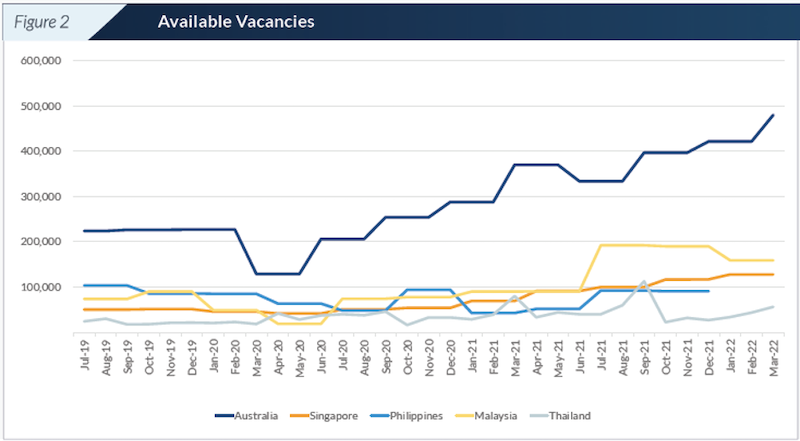APAC Talent Markets in 2022: 5 Key Data Insights
Magnit | August 11 2022 |

The recently released July 2022 APAC Labor Market Report reveals volatile Asia-Pacific labor markets where businesses are facing challenges in hiring and retaining talent in critical labor categories such as IT. But leading APAC businesses are proving resilient and have been adapting since the start of the COVID-19 pandemic, taking steps that include enhancing pay and benefits, promoting workplace flexibility, and changing how high-demand talent is engaged.
Based on Magnit’s industry-leading global talent market data ecosystem and talent intelligence capabilities, the report shines a spotlight on these conditions and changes, along with details on how they vary across several different APAC countries.
Here are five key insights into what businesses across the region are facing and doing:
1) APAC Markets Are Rebounding After Pandemic Shock
After the initial jump in unemployment across the region in early 2020, unemployment rates have decreased steadily. By January 2022, the unemployment rate had dipped below pre-pandemic levels in Australia, India and Singapore and nearly reached pre-pandemic levels in Philippines, Malaysia, Indonesia and Thailand.
As economies bounced back, the number of open positions in most countries returned to pre-pandemic levels within two quarters. Vacancies have generally continued to increase since then, driven by rising demand and sometimes regulatory supply constraints. By March 2022, job vacancies in Australia had risen over 86% compared to pre-pandemic figures, with vacancies increasing in Singapore, Malaysia and Thailand by 127%, 111% and 60% respectively.

2) Competition For IT Talent Is Intensifying
Over this period, businesses seeking critical talent have increasingly faced hiring and retention challenges. Competition for IT talent, in what is effectively now a sellers' market, has become fraught for most businesses across the region.
The time-to-fill rates for IT vacancies remain significantly elevated compared to pre-pandemic rates. For example, the time it takes to fill IT positions in Australia rose approximately 25% from 2019 to 2021, with organizations taking two to three months to hire a well-qualified candidate with niche skills. Businesses in other countries face similar time frames. Bill rates have also risen across the region since 2020, driving higher compensation costs for in-demand technical talent.
3) Creating An Electrifying Employer Brand is Now Essential
APAC countries have high rates of digital/mobile penetration, and word gets around in a tech-savvy population of young workers. High-performing APAC businesses are recognizing that the talent acquisition game has changed and that making employer brand a magnet for talent is necessary to attract and engage top talent.
Creating a talent brand means implementing a new talent acquisition strategy quite different from traditional hiring practices:
- AI-driven direct sourcing technology combined with data and predictive analytics are critical to growing an effective employer brand
- Sophisticated digital candidate marketing campaigns must be designed and conducted to reach and attract in-demand talent
- A specialized workforce management platform — not just an Applicant Tracking System — and talent intelligence are key to effectively source candidates and curate talent pools
4) Using Market Data to Design Competitive Compensation Packages Is Crucial
One of the ways in which businesses have responded to IT hiring and retention challenges across the region has been by offering higher pay and enhanced benefits. However, many organizations are hamstrung by the lack of accurate salary data and benchmarks for specific roles in different country or local labor markets. To offer competitive compensation, pay rates must be tied to up-to-date market rate intelligence.
For technical positions, companies in Singapore and Australia have responded to the tight market by increasing pay by 20% or more. Since competitive pay can be matched and lead to an upward cost spiral, companies are also differentiating themselves by offering improved health benefits as well as perks like private healthcare, gym memberships, wellness programs, and strong training and development plans.
5) Turning Remote and Hybrid Work Into a Win-Win is Imperative
Most leading businesses in the region have embraced remote and hybrid work as the new normal, acknowledging that it’s a highly coveted option for workers (and a powerful inducement to in-demand tech workers who have traditionally worked in offices). As in other regions of the world, workers recognize its value in terms of workplace flexibility, reduced commute and better work-life balance, making it a sellable differentiator.
Businesses can also benefit from the shift to a remote work paradigm. For example, It may reduce the high costs of offices in APAC cities. More importantly, it’s a way to broaden the talent funnel by hiring and retaining talent in different geographies. But to capitalize on these sourcing opportunities, quality data and analytics are needed to pinpoint locations of untapped sourcing opportunities based on pay rate, worker skills and availability, and other parameters.
To learn more about the state of the APAC labor market, including exclusive market and talent intelligence you can use to win the war for talent in different countries across the region, download the full July 2022 APAC Labor Market Report.
If you’re interested in learning more about how Magnit is helping organizations implement winning contingent workforce programs globally, please contact a Magnit representative at info@magnitglobal.com.
Disclaimer: The content in this blog post is for informational purposes only and cannot be construed as specific legal advice or as a substitute for legal advice. The blog post reflects the opinion of Magnit and is not to be construed as legal solutions and positions. Contact an attorney for specific advice and guidance for specific issues or questions.
